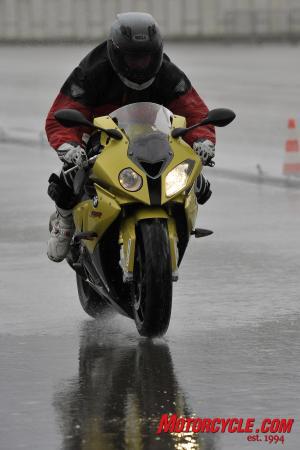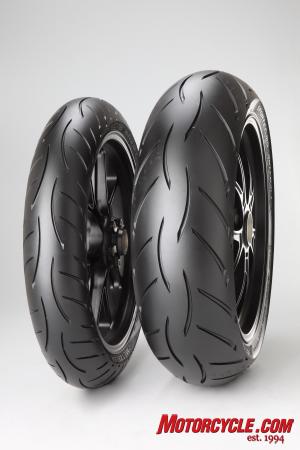Elephants, Metzeler’s logo, are embossed along the edges of the company’s new Sportec M5. Our job was to kill them.
But before you slay the elephant, first you must pass the tire’s 5-stage lean-angle indicator, a series of numbers from 1 to 5 that Chris Wall, Metzeler’s U.S. director of marketing, describes as a “chicken-strip meter.”
When scrubbing number 1, you’re only leaning over about 25 degrees. You’ll have to be cranked over about 45 degrees to burn off the number-5 section. And then the elephant hunting begins.
Decoding the beast
The Sportec sits between the sport-touring Roadtec and track-ready Racetec, and the M5 replaces the Sportec M3. But there’s more to the story.
The Sportec M5 also includes Metzeler’s newish Interact technology (already employed in the Racetec and Roadtec) in which its zero-degree steel belts are arranged with varying tension levels in strategic zones along its profile. The M5 is divided into three sections. High-tension cords are used at the edge of the tire for stability and feedback, and also in the center of the tire for durability. Between those two segments of the tire is a low-tension area for quick warm-up and better grip at street-typical lean angles.
“Altering the tension of steel belts affects a tire’s stability, grip and mileage,” says Metzeler R&D Director, Dr. P. Kronthaler. “And performance of the tire compound is influenced by the belt’s tension.”
The Interact tech allows a multi-zone tire that isn’t encumbered with the step between compounds as in dual- or tri-compound rubber, allowing for a more continuous transition from zone to zone.
The multiple-tension belts and a new polymer foundation allow the tire to have a silica content 55% greater than the Sportec M3. Silica is a key ingredient in supplying wet grip and ensuring quick warm-up. The Racetec, conversely, uses carbon black instead of silica, as silica “suffers a lot at high temperatures,” explains Salvo Pennisi, Metzeler’s chief test rider.
The Racetec’s lack of silica and its minimal tread siping make it a less versatile street tire than the Sportec M5. But the track-performance cost of the M5 is quite small. Pennisi says the new Sportec is only about 1 second slower than the Racetec around a 3-mile track.
The Sportec M5 also boasts a new tread pattern inspired by the Greek letter Pi, with two lateral sipes capped by a longitudinal one. A well-rounded performance tire like this needs to be able to handle wet conditions, and Metzeler says two grooves in the front M5 are always in contact with the road to evacuate water. Out back, the contact patch always touches at least one groove.
Compared to the Sportec M3, Metzeler claims the M5 has improvements in both dry and wet performance while durability remains constant. The greatest advance over the M3, according to a Metzeler chart, is in the “riding easiness” category.
Testing, testing, 1-2-3…
Metzeler invited the moto press to test the new Sportec at the fantastic Portimao circuit in Portugal’s Algarve region. Pennisi says the hilly track is a good simulator for a challenging mountain road.
The Metzeler reps showed their faith in the M5’s ability to warm quickly by not bothering to employ tire warmers. The new buns were mounted on a variety of sporty bikes, as Metzeler intends the new tire to have a wide range of application, everything from sport nakeds to race-reps to large supermotos.
I selected an exotic BMW HP2 Sport for my first stint on the shiny, new tires. In hindsight, this probably wasn’t the best choice, as the HP2’s Boxer motor, Telelever fork and shaft drive makes it a bit of a strange duck and provides atypical feedback compared to a traditional sportbike.
However, it didn’t take long before I was able to trust the grip from the M5s, and I was soon able to confidently lean the HP2 far enough to drag its rear-set footpegs. I began to enjoy the tires’ neutral turn-in response and track-worthy adhesion.
A post-ride inspection of the tires showed I had scuffed all the lean-angle indicator numbers, but I had only decapitated the elephant, leaving the pachyderm’s body unscathed.
The elephant would have the last laugh on this day, as a light rain began to fall while I zinged out of pit lane on a new Yamaha YZF-R6, ensuring only modest lean angles. But since we were there to test tires – and ones that have been developed for wet use – it turned out to be perfect conditions.
Although presented with a cool, damp track, the Sportec M5s came up to temperature quickly and were surprisingly trustworthy in the treacherous conditions. My confidence swelled, allowing me the speed to pass several riders and drag a knee puck a few times. I occasionally felt the rear tire spin up while accelerating leaned over out of corners, but it always happened predictably and was easily controlled.
In this kind of dicey environment, I was happy to be on the Sportec M5 rather than the Racetec with its stiffer construction and absence of silica.
HAL 9000 Is My Co-Pilot
Electronic rider aids have been described as crutches. But unless your last name is Rossi, your skills could probably use the help – especially when it’s raining.
These were my thoughts after pounding out laps on BMW’s tech-heavy and blindingly fast S1000RR around the challenging Portimao circuit in a sodden downpour. With its traction control and antilock brakes, it was like cheating.
It was also an excellent way to explore the wet grip from the Sportec M5s without balling up the bike in a gravel trap.
Again the M5s demonstrated their ability to evacuate water and retain traction on a soggy surface. BMW’s DTC was ideal for checking acceleration grip, as the throttle could fearlessly be whacked open during corner exits. Considering the wet surface, the force of acceleration was phenomenal, even pulling up the front wheel occasionally.
Traction in the corners proved to be fairly abundant, although my knee puck (and the pesky elephant!) weren’t in danger of being scuffed. Turn-in response remained as neutral as it was on the other bikes I tested, even though this was a 190mm rear tire instead of the 180/55-17 on the R6. Metzeler notes that each size of Sportec was developed on its own, explaining that some other manufacturers develop one particular size which is then modified for other sizes.
Wet-braking grip, too, was sensational, as the ABS allowed me to use nearly the same brake markers as I did in the dry. It will be very interesting to watch a rainy World Superbike race this year, as both Honda and BMW have homologated their ABS systems for 2010 Superbike use, which should give them a decided advantage in the wet.
Perhaps the most salient point brought up during my S1000RR stint was that no one passed me all session, which isn’t usually the case when riding amongst the typical motojournalist grand prix.
The Verdict
Metzeler couldn’t have planned a more perfect environment in which to test the new Sportec M5 Interact. The track itself is hugely entertaining, and we were able to ride in sessions that ranged from full dry to soaking wet.
Through it all, the Sportec M5s performed as well as could be expected. Dry grip was excellent, and we barely even approached their racetrack limits. In damp conditions, traction was abundant enough to drag a knee. Adhesion during wet braking tests was greater than most riders use on the street in dry conditions. And, even during a deluge, the M5s supplied the traction and confidence necessary to clock in respectable lap times at Portimao.
All-weather sport riders will enjoy the versatility and performance of the Sportec M5 Interact. Fashionistas will dig the tread pattern and lean-angle indicator zones.
The new Sportec is hitting dealers now and is available in popular sizes for 17-inch wheels. Suggested retail prices are around $180 for fronts; $221.95 to 281.95 for rears. Keep in mind that a careful shopper can find tires at much-reduced sale prices. For more, check out www.us.metzelermoto.com
Meanwhile, I can’t wait to go elephant hunting again.
Source : motorcycle.com
But before you slay the elephant, first you must pass the tire’s 5-stage lean-angle indicator, a series of numbers from 1 to 5 that Chris Wall, Metzeler’s U.S. director of marketing, describes as a “chicken-strip meter.”
When scrubbing number 1, you’re only leaning over about 25 degrees. You’ll have to be cranked over about 45 degrees to burn off the number-5 section. And then the elephant hunting begins.
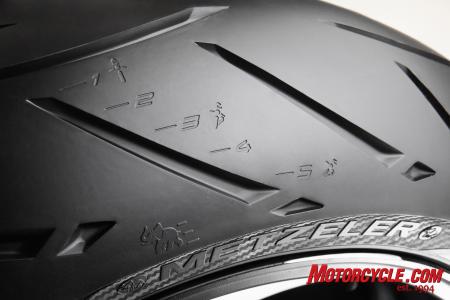 Metzeler’s new Sportec M5 Interact, complete with 5-stage lean-angle indicator and a pesky elephant. |
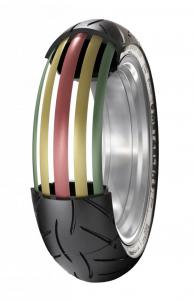 Interact_Tension_inside |
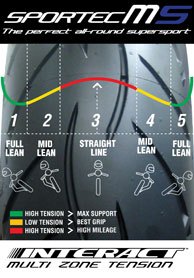 Varying tension of the Interact’s zero-degree steel belts optimize them for the differing loads subjected to each part of the tire. |
The Sportec M5 also includes Metzeler’s newish Interact technology (already employed in the Racetec and Roadtec) in which its zero-degree steel belts are arranged with varying tension levels in strategic zones along its profile. The M5 is divided into three sections. High-tension cords are used at the edge of the tire for stability and feedback, and also in the center of the tire for durability. Between those two segments of the tire is a low-tension area for quick warm-up and better grip at street-typical lean angles.
“Altering the tension of steel belts affects a tire’s stability, grip and mileage,” says Metzeler R&D Director, Dr. P. Kronthaler. “And performance of the tire compound is influenced by the belt’s tension.”
The Interact tech allows a multi-zone tire that isn’t encumbered with the step between compounds as in dual- or tri-compound rubber, allowing for a more continuous transition from zone to zone.
The multiple-tension belts and a new polymer foundation allow the tire to have a silica content 55% greater than the Sportec M3. Silica is a key ingredient in supplying wet grip and ensuring quick warm-up. The Racetec, conversely, uses carbon black instead of silica, as silica “suffers a lot at high temperatures,” explains Salvo Pennisi, Metzeler’s chief test rider.
The Racetec’s lack of silica and its minimal tread siping make it a less versatile street tire than the Sportec M5. But the track-performance cost of the M5 is quite small. Pennisi says the new Sportec is only about 1 second slower than the Racetec around a 3-mile track.
The Sportec M5 also boasts a new tread pattern inspired by the Greek letter Pi, with two lateral sipes capped by a longitudinal one. A well-rounded performance tire like this needs to be able to handle wet conditions, and Metzeler says two grooves in the front M5 are always in contact with the road to evacuate water. Out back, the contact patch always touches at least one groove.
Compared to the Sportec M3, Metzeler claims the M5 has improvements in both dry and wet performance while durability remains constant. The greatest advance over the M3, according to a Metzeler chart, is in the “riding easiness” category.
Testing, testing, 1-2-3…
Metzeler invited the moto press to test the new Sportec at the fantastic Portimao circuit in Portugal’s Algarve region. Pennisi says the hilly track is a good simulator for a challenging mountain road.
The Metzeler reps showed their faith in the M5’s ability to warm quickly by not bothering to employ tire warmers. The new buns were mounted on a variety of sporty bikes, as Metzeler intends the new tire to have a wide range of application, everything from sport nakeds to race-reps to large supermotos.
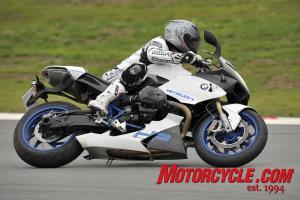 BMW’s oddball HP2 Sport provided our first chance to assassinate Metzeler’s elephant. |
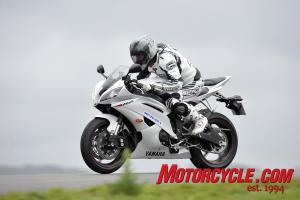 A light rain fell on our session aboard the racy Yamaha R6, but the fun continued unabated. |
However, it didn’t take long before I was able to trust the grip from the M5s, and I was soon able to confidently lean the HP2 far enough to drag its rear-set footpegs. I began to enjoy the tires’ neutral turn-in response and track-worthy adhesion.
A post-ride inspection of the tires showed I had scuffed all the lean-angle indicator numbers, but I had only decapitated the elephant, leaving the pachyderm’s body unscathed.
The elephant would have the last laugh on this day, as a light rain began to fall while I zinged out of pit lane on a new Yamaha YZF-R6, ensuring only modest lean angles. But since we were there to test tires – and ones that have been developed for wet use – it turned out to be perfect conditions.
Although presented with a cool, damp track, the Sportec M5s came up to temperature quickly and were surprisingly trustworthy in the treacherous conditions. My confidence swelled, allowing me the speed to pass several riders and drag a knee puck a few times. I occasionally felt the rear tire spin up while accelerating leaned over out of corners, but it always happened predictably and was easily controlled.
In this kind of dicey environment, I was happy to be on the Sportec M5 rather than the Racetec with its stiffer construction and absence of silica.
HAL 9000 Is My Co-Pilot
Electronic rider aids have been described as crutches. But unless your last name is Rossi, your skills could probably use the help – especially when it’s raining.
These were my thoughts after pounding out laps on BMW’s tech-heavy and blindingly fast S1000RR around the challenging Portimao circuit in a sodden downpour. With its traction control and antilock brakes, it was like cheating.
It was also an excellent way to explore the wet grip from the Sportec M5s without balling up the bike in a gravel trap.
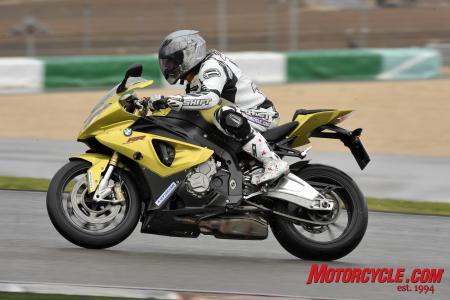 Traction control and antilock brakes: Duke gladly takes all the help he can get! |
Traction in the corners proved to be fairly abundant, although my knee puck (and the pesky elephant!) weren’t in danger of being scuffed. Turn-in response remained as neutral as it was on the other bikes I tested, even though this was a 190mm rear tire instead of the 180/55-17 on the R6. Metzeler notes that each size of Sportec was developed on its own, explaining that some other manufacturers develop one particular size which is then modified for other sizes.
Wet-braking grip, too, was sensational, as the ABS allowed me to use nearly the same brake markers as I did in the dry. It will be very interesting to watch a rainy World Superbike race this year, as both Honda and BMW have homologated their ABS systems for 2010 Superbike use, which should give them a decided advantage in the wet.
Perhaps the most salient point brought up during my S1000RR stint was that no one passed me all session, which isn’t usually the case when riding amongst the typical motojournalist grand prix.
The Verdict
Metzeler couldn’t have planned a more perfect environment in which to test the new Sportec M5 Interact. The track itself is hugely entertaining, and we were able to ride in sessions that ranged from full dry to soaking wet.
Through it all, the Sportec M5s performed as well as could be expected. Dry grip was excellent, and we barely even approached their racetrack limits. In damp conditions, traction was abundant enough to drag a knee. Adhesion during wet braking tests was greater than most riders use on the street in dry conditions. And, even during a deluge, the M5s supplied the traction and confidence necessary to clock in respectable lap times at Portimao.
All-weather sport riders will enjoy the versatility and performance of the Sportec M5 Interact. Fashionistas will dig the tread pattern and lean-angle indicator zones.
The new Sportec is hitting dealers now and is available in popular sizes for 17-inch wheels. Suggested retail prices are around $180 for fronts; $221.95 to 281.95 for rears. Keep in mind that a careful shopper can find tires at much-reduced sale prices. For more, check out www.us.metzelermoto.com
Meanwhile, I can’t wait to go elephant hunting again.
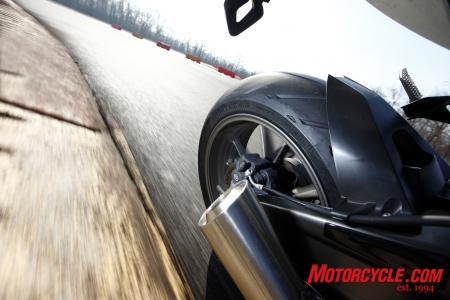 This is how dry we wished Portimao was for our S1000RR sessions! |
